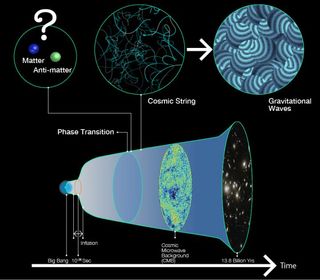Cosmic strings from the Big Bang may have left behind ripples in space-time

Inflation stretched the tiny universe into a macroscopic size and turned cosmic energy into matter. But it likely created an equal amount of matter and antimatter. It's not clear why but the authors probe one theory that a phase transition after inflation led to a tiny bit more matter than anti-matter and also created cosmic strings which would produce slight ripples in space-time known as gravitational waves.
(Image: © R. Hurt/Caltech-JPL, NASA, and ESA Credit: Kavli IPMU - Kavli IPMU modified this figure based on the image credited by R.Hurt/Caltech-JPL, NASA, and ESA)
A new study may help answer one of the universe's biggest mysteries: Why is there more matter than antimatter? That answer, in turn, could explain why everything from atoms to black holes exists.
Billions of years ago, soon after the Big Bang, cosmic inflation stretched the tiny seed of our universe and transformed energy into matter. Physicists think inflation initially created the same amount of matter and antimatter, which annihilate each other on contact. But then something happened that tipped the scales in favor of matter, allowing everything we can see and touch to come into existence — and a new study suggests that the explanation is hidden in very slight ripples in space-time./.../
,,,,,,,,,,,,,,,,,,,,,,,,,,,,,,,,,,,,,,,,,,,,,,,,,,,
,,,,,,,,,,,,,,,,,,,,,,,,,,,,,,,,,,,,,,,,,,,,,,,,,,,
|
A singularity is where conventional physics breaks down, including if you’re talking about the very beginning of the Universe. However, there are consequences to achieving arbitrarily hot, dense states in the Universe, and many of them fail to hold up to observations. (© 2007–2016, MAX PLANCK INSTITUTE FOR GRAVITATIONAL PHYSICS, POTSDAM)

For over 50 years, it’s been the scientifically accepted theory describing the origin of the Universe. It’s…
|
No comments:
Post a Comment